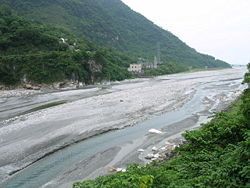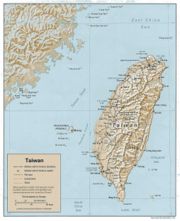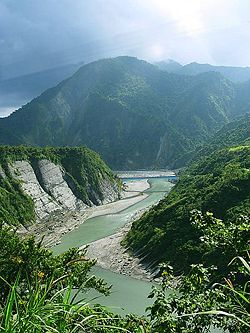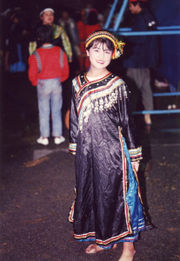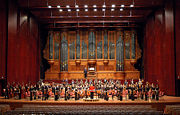Taiwan
2008/9 Schools Wikipedia Selection. Related subjects: Asia; Asian Countries
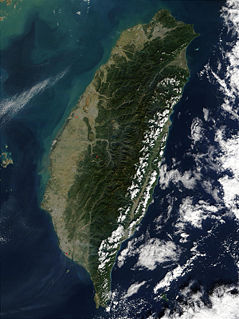 Taiwan is mostly mountainous in the east and gently sloping plains in the west. The Penghu Islands (the Pescadores) are west of Taiwan (Satellite photo by NASA). |
|
| Geography | |
|---|---|
 |
|
| Location | Pacific Ocean, 120 km (74.6 mi) off the coast of mainland China |
| Coordinates | |
| Area | 35,801 km² (13,822.8 sq mi) |
| Rank | 39th |
| Highest point | Yu Shan — 3,952 m (2.5 mi) () |
| Administration | |
| Demographics | |
| Population | approx. 23 million (as of 2005) |
| Density | {{{density}}}/km² |
| Ethnic groups | Taiwanese people 98% Han Chinese 70% Hoklo 14% Hakka 14% Mainlander 2% Aboriginal Taiwanese |
| Please note that all population percentages are those of the total population of the island | |
Taiwan ( traditional Chinese: 臺灣 or 台灣; simplified Chinese: 台湾; Hanyu Pinyin: Táiwān; Tongyong Pinyin: Táiwan; Wade-Giles: T'ai²-wan¹; Taiwanese: 大圓, Tâi-oân) is an island in East Asia. "Taiwan" is also commonly used to refer to the territories governed by the Republic of China (ROC) and to ROC itself, which governs the island of Taiwan, Orchid Island and Green Island in the Pacific off the Taiwan coast, the Pescadores in the Taiwan Strait, and Kinmen and the Matsu Islands off the coast of mainland Fujian. The island groups of Taiwan and Penghu (except the municipalities of Taipei and Kaohsiung) are officially administered as Taiwan Province of the ROC. However, in practice, almost all government power is exercised at the national and local (city/county) levels.
Taiwan is also currently claimed by the People's Republic of China (PRC) as a PRC province, though the government of the PRC has never controlled Taiwan island or any of the current ROC territory commonly referred to as "Taiwan".
The main island of Taiwan, also known as Formosa (from Portuguese (Ilha) Formosa, meaning "beautiful (island)"), is located in East Asia off the coast of mainland China, southwest of the main islands of Japan but directly west of the end of Japan's Ryukyu Islands, and north-northwest of the Philippines. It is bound to the east by the Pacific Ocean, to the south by the South China Sea and the Luzon Strait, to the west by the Taiwan Strait and to the north by the East China Sea. The island is 394 kilometers (245 miles) long and 144 kilometers (89 miles) wide and consists of steep mountains covered by tropical and subtropical vegetation.
History
Prehistory
Evidence of human settlement in Taiwan dates back thirty thousand years, although the first inhabitants of Taiwan may have been genetically distinct from any groups currently on the island. About four thousand years ago, ancestors of current Taiwanese aborigines settled in Taiwan. These aborigines are genetically related to Malay and Polynesians, and linguists classify their languages as Austronesian. Polynesians are suspected to have ancestry traceable back to Taiwan.
Early settlement
Han Chinese began settling in the Pescadores in the 1200s, but Taiwan's hostile tribes and its lack of the trade resources valued in that era rendered it unattractive to all but "occasional adventurers or fishermen engaging in barter" until the sixteenth century.
Records from ancient China indicate that Han Chinese might have known of the existence of the main island of Taiwan since the Three Kingdoms period (third century, 230 A.D.), having assigned offshore islands in the vicinity names like Greater Liuqiu and Lesser Liuqiu ( etymologically, but perhaps not semantically, identical to Ryūkyū in Japanese), though none of these names has been definitively matched to the main island of Taiwan. It has been claimed but not verified that the Ming Dynasty admiral Cheng Ho (Zheng He) visited Taiwan between 1403 and 1424.
European settlement
In 1544, a Portuguese ship sighted the main island of Taiwan and dubbed it "Ilha Formosa", which means "Beautiful Island." The Portuguese made no attempt to colonize Taiwan.
In 1624, the Dutch established a commercial base on Taiwan and began to import workers from Fujian and Penghu as laborers, many of whom settled. The Dutch made Taiwan a colony with its colonial capital at Tayoan City (present day Anping, Tainan). Both Tayoan and the island name Taiwan derive from a word in Sirayan, one of the Formosan languages.
The Dutch military presence was concentrated at a stronghold called Castle Zeelandia. The Dutch colonists also started to hunt the native Formosan Sika deer (Cervus nippon taioanus) that inhabited Taiwan, contributing to the eventual extinction of the subspecies on the island.
Koxinga and Imperial Chinese rule
Naval and troop forces of Southern Fujian defeated the Dutch in 1662, subsequently expelling the Dutch government and military from the island. They were led by Koxinga ( traditional Chinese: 鄭成功; simplified Chinese: 郑成功; pinyin: Zhèng Chénggōng). Following the fall of the Ming Dynasty, Koxinga retreated to Taiwan as a self-styled Ming loyalist and established the Kingdom of Tungning (1662–83). Koxinga established his capital at Tainan and he and his heirs, Zheng Jing ( traditional Chinese: 鄭經; simplified Chinese: 郑经; pinyin: Zhèng Jīng), who ruled from 1662–82, and Zheng Keshuang ( traditional Chinese: 鄭克塽; simplified Chinese: 郑克塽; pinyin: Zhèng Kèshuàng), who served less than a year, continued to launch raids on the south-east coast of mainland China well into the Qing Dynasty, attempting to recover the mainland.
In 1683, following the defeat of Koxinga's grandson by an armada led by Admiral Shi Lang of Southern Fujian, the Qing Dynasty formally annexed Taiwan, placing it under the jurisdiction of Fujian province. The Qing Dynasty government tried to reduce piracy and vagrancy in the area, issuing a series of edicts to manage immigration and respect aboriginal land rights. Immigrants mostly from Southern Fujian continued to enter Taiwan. The border between taxpaying lands and "savage" lands shifted eastward, with some aborigines ' Sinicizing' while others retreated into the mountains. During this time, there were a number of conflicts between Chinese from different regions of Southern Fujian, and between Southern Fujian Chinese and aborigines.
In 1887, the Qing government upgraded Taiwan's status from prefecture of Fujian to full province, the twentieth in the country, with its capital at Taipei. This was accompanied by a modernization drive that included building Taiwan's first railroad and starting a postal service.
Japanese rule
Imperial Japan had sought to control Taiwan since 1592, when Toyotomi Hideyoshi began extending Japanese influence overseas. In 1609, the Tokugawa Shogunate sent Arima Harunobu on an exploratory mission. In 1616, Murayama Toan led an unsuccessful invasion of the island.
In 1871, an Okinawan vessel shipwrecked on the southern tip of Taiwan and the crew of fifty-four were beheaded by the Paiwan aborigines. When Japan sought compensation from Qing China, the court rejected the demand on the grounds that the "wild"/"unsubjugated" aboriginals ( traditional Chinese: 台灣生番; simplified Chinese: 台湾生番; pinyin: Táiwān shēngfān) were outside its jurisdiction. This open renunciation of sovereignty led to a Japanese invasion of Taiwan. In 1874, an expeditionary force of three thousand troops was sent to the island. There were about thirty Taiwanese and 543 Japanese casualties (twelve in battle and 531 by endemic diseases).
Qing China was defeated in the First Sino-Japanese War (1894–95), and ceded Taiwan and the Pescadores to Japan in perpetuity in the Treaty of Shimonoseki. Inhabitants wishing to remain Chinese subjects were given a two-year grace period to sell their property and remove to mainland China. Very few Taiwanese saw this as feasible.
On May 25, 1895, a group of pro-Qing high officials proclaimed the Republic of Formosa to resist impending Japanese rule. Japanese forces entered the capital at Tainan and quelled this resistance on October 21, 1895.
The Japanese were instrumental in the industrialization of the island; they extended the railroads and other transportation networks, built an extensive sanitation system and revised the public school system. During this period, both rice and sugarcane production greatly increased. At one point, Taiwan was the seventh greatest sugar producer in the world. Still, the ethnic Chinese and Taiwanese aborigines were classified as second- and third-class citizens. Large-scale violence continued in the first decade of rule. Japan launched over 160 battles to destroy Taiwan's aboriginal tribes during its 51-year rule of the island …' Around 1935, the Japanese began an island-wide assimilation project to bind the island more firmly to the Japanese Empire. The plan worked very well, to the point that tens of thousands of Taiwanese joined the Japanese army ranks, and fought loyally for them. For example, former ROC President Lee Teng-hui's elder brother served in the Japanese navy and died while on duty in February 1945 in the Philippines.
Taiwan played a significant part in the system of Japanese prisoner of war camps that extended across South-East Asia between 1942 and 1945.' Allied POW's, as well as 'women and children as young as seven or eight years old,' were brutally enslaved at various locations like at the copper mine northwest of Keelung, sadistically supervised by Taiwanese and Japanese. '… it was found that, while the Japanese were invariably proud to give their name and rank, Taiwanese soldiers and 'hanchos' invariably concealed their names … some Taiwanese citizens … were willing participants in war crimes of various degrees of infamy … young males were to an extent highly nipponized; in fact a proportion in the 1930s are reported to have been actively hoping for a Japanese victory in China … One of the most tragic events of the whole Pacific war took place in Kaohsiung. This was the bombing of the prison ship Enoura Maru in Kaohsiung harbour on January 9th 1945.'
The Imperial Japanese Navy operated heavily out of Taiwan. The " South Strike Group" was based out of the Taihoku Imperial University in Taiwan. Many of the Japanese forces participating in the Aerial Battle of Taiwan-Okinawa were based in Taiwan. Important Japanese military bases and industrial centers throughout Taiwan, like Kaohsiung, were targets of heavy American bombing.
By 1945, just before Japan lost World War II, desperate plans were put in place to incorporate popular representation of Taiwan into the Japanese Diet to make Taiwan an integral part of Japan proper.
Japan's rule of Taiwan ended when it lost World War II and signed the Instrument of Surrender of Japan on August 15, 1945. But the Japanese occupation had long lasting effects on Taiwan and Taiwanese culture. Taiwanese tend to have a more positive view of Japan than other Asians. Significant parts of Taiwanese infrastructure were started under the Japanese rule. The current Presidential Building was also built during that time.
Kuomintang martial law period
On October 25, 1945, ROC troops representing the Allied Command accepted the formal surrender of Japanese military forces in Taihoku. The ROC Government, led by Chiang Kai-shek, announced that date as "Taiwan Restoration Day" ( traditional Chinese: 臺灣光復節; simplified Chinese: 台湾光复节; Hanyu Pinyin: Táiwān Guāngfùjié; Tongyong Pinyin: Táiwan Guangfùjié). They were greeted as liberators by some Taiwanese. Many other Taiwanese, however, who fought against China and the allies for the Japanese war machine greeted them reluctantly, this new generation of Chinese arrivals. The ROC under Chen Yi was generally unstable and corrupt; it seized the people's property and set up government monopolies of many industries. Many problems like this, compounded with hyperinflation, unrest due to the Chinese Civil War, and distrust due to political, cultural and linguistic differences between the Taiwanese and the Mainland Chinese, quickly led to the loss of popular support for the new government. This culminated in a series of severe clashes between the ROC government and Taiwanese, in turn leading to the bloody 228 incident and the reign of White Terror.
In 1949, during the Chinese Civil War, the Kuomintang (KMT), led by Chiang Kai-shek, retreated from Mainland China and moved the ROC government from Nanjing to Taipei, Taiwan's largest city, while continuing to claim sovereignty over all of China, Outer Mongolia as well as other areas. On the mainland, the victorious Communists established the PRC, claiming to be the sole representative of China including Taiwan and portraying the ROC government on Taiwan as an illegitimate entity.
Some 2 million refugees from Mainland China, consisting mainly of soldiers, KMT party members and most importantly the intellectual and business elites fled the mainland and arrived in Taiwan around that time. In addition, as part of its escape from Communists on the mainland, the ROC government relocated to Taiwan with many national treasures including gold reserves and foreign currency reserves. This was often used by the PRC government to explain its economic difficulties and Taiwan's comparative prosperity. From this period through the 1980s, Taiwan was governed by a party-state dictatorship, with the KMT as the ruling party. Military rule continued and little to no distinction was made between the government and the party, with public property, government property, and party property being interchangeable. Government workers and party members were indistinguishable, with government workers, such as teachers, required to become KMT members, and party workers paid salaries and promised retirement benefits along the lines of government employees. In addition all other parties were outlawed, and political opponents were persecuted, incarcerated, and executed.
Taiwan remained under martial law and one-party rule, under the name of the " Temporary Provisions Effective During the Period of Communist Rebellion" ( traditional Chinese: 動員戡亂時期臨時條款; simplified Chinese: 动员戡乱时期临时条款; Hanyu Pinyin: dòngyuán kānluàn shíqí línshí tiáokuǎn; Tongyong Pinyin: dòngyuán kanluàn shíhcí línshíh tiáokuǎn), from 1948 to 1987, when the ROC Presidents Chiang Ching-kuo and Lee Teng-hui gradually liberalized and democratized the system. With the advent of democratization, the issue of the political status of Taiwan has resurfaced as a controversial issue (previously, discussion of anything other than unification under the ROC was taboo).
As the Chinese Civil War continued without truce, the ROC built up military fortification works throughout Taiwan. Within this effort, former KMT soldiers built the now famous Central Cross-Island Highway through the Taroko Gorge in the 1950s. The two sides would remain in a heightened military state well into the 1960’s on the islands on the border with unknown number of night raids and clashes with details that are rarely made public. During the Second Taiwan Strait Crisis in September 1958, Taiwan's landscape added Nike-Hercules Missile batteries with the formation of the 1st Missile Battalion Chinese Army and would not be deactivated until 1997. Newer generations of missile batteries have since replaced the Nike Hercules systems throughout the island.
During the 1960s and 1970s, the ROC began to develop into a prosperous, industrialized developed country with a strong and dynamic economy, becoming one of the Four Asian Tigers while maintaining the authoritarian, single-party government. Because of the Cold War, most Western nations and the United Nations regarded the ROC as the sole legitimate government of China (while being merely the de-facto government of Taiwan) until the 1970s, when most nations began switching recognition to the PRC.
Modern democratic era
Chiang Kai-shek's eventual successor, his son Chiang Ching-kuo, began to liberalize Taiwan's political system. In 1984, the younger Chiang selected Lee Teng-hui, a native Taiwanese technocrat, to be his vice president. In 1986, the Democratic Progressive Party (DPP) was formed illegally and inaugurated as the first opposition party in Taiwan to counter the KMT. A year later Chiang Ching-kuo lifted martial law.
After the 1988 death of Chiang Ching-Kuo, his successor as President Lee Teng-hui continued to hand more government authority over to the native Taiwanese and democratize the government. Under Lee, Taiwan underwent a process of localization in which local culture and history was promoted over a pan-China viewpoint. Lee's reforms included printing banknotes from the Central Bank rather than the Provincial Bank of Taiwan, and disbanding the Taiwan Provincial Government. Under Lee, the original members of the Legislative Yuan and National Assembly, elected in 1947 to represent mainland constituencies and having taken the seats without re-election for more than four decades, were forced to resign in 1991. Restrictions on the use of Taiwanese in the broadcast media and in schools were lifted as well.
In the 1990s, the ROC transformed into a true democratic country, as President Lee Teng-hui was elected by the first popular vote held in Taiwan during the 1996 Presidential election. In 2000, Chen Shui-bian of the DPP, was elected as the first non- KMT President and was re-elected to serve his second and last term since 2004. Polarized politics has emerged in Taiwan with the formation of the Pan-Blue Coalition of parties led by the KMT, favoring eventual Chinese reunification, and the Pan-Green Coalition of parties led by the DPP, favoring an eventual and official declaration of Taiwan independence.
On September 30, 2007, the ruling Democratic Progressive Party approved a resolution asserting separate identity from China and called for the enactment of a new constitution for a "normal country". It also called for general use of "Taiwan" as the island's name, without abolishing its formal name, the Republic of China. The Chen administration also pushed for referendums on national defense and UN entry in the 2004 and 2008 elections, which failed due to voter turnout below the required legal threshold of 50% of all registered voters. The Chen administration was also dogged by public concern over reduced economic growth, legislative gridlock due to a pan-blue controlled Legislative Yuan, and alleged corruption scandals involving the First Family.
The KMT increased its majority in the Legislative Yuan in the January 2008 legislative elections, while its nominee Ma Ying-jeou went on to win the presidency in March of the same year, campaigning on a platform of increased economic growth, and better ties with the Mainland China under a policy of "mutual nondenial". Ma took office on May 20, 2008.
Geography
The island of Taiwan lies some 120 kilometers off the southeastern coast of mainland China, across the Taiwan Strait, and has an area of 35,801 km² (13,822.8 sq mi). The East China Sea lies to the north, the Philippine Sea to the east, the Luzon Strait directly to the south and the South China Sea to the southwest. The island is characterized by the contrast between the eastern two-thirds, consisting mostly of rugged mountains running in five ranges from the northern to the southern tip of the island, and the flat to gently rolling plains in the west that are also home to most of Taiwan's population. Taiwan's highest point is the Yu Shan at 3,952 meters, and there are five other peaks over 3,500 meters. This makes it the world's seventh-highest island. Taroko National Park, located on the mountainous eastern side of the island, has good examples of mountainous terrain, gorges and erosion caused by a swiftly flowing river.
The shape of the main island of Taiwan is similar to a sweet potato seen in a south-to-north direction, and therefore, Taiwanese people, especially the Min-nan division, often call themselves "children of the Sweet Potato." There are also other interpretations of the island shape, one of which is a whale in the ocean (the Pacific Ocean) if viewed in a west-to-east direction, which is a common orientation in ancient maps, plotted either by Western explorers or the Qing Dynasty.
Geology
The island of Taiwan lies in a complex tectonic area between the Eurasian Plate and the Philippine Plate. The upper part of the crust on the island is primarily made up of a series of terranes, mostly old island arcs which have been forced together by the collision of the Eurasian and Philippine plates. These have been further uplifted as a result of the detachment of a portion of the Eurasian Plate as it subducted beneath the Philippine Plate, a process which left the crust under Taiwan more buoyant.
The major seismic faults in Taiwan correspond to the various suture zones between the various terranes. These have produced major quakes throughout the history of the island. On September 21, 1999, a 7.3 quake known as the " Chi-Chi earthquake" occurred.
Climate
Taiwan's climate is marine tropical. The Northern part of the island has a rainy season that lasts from January to late March during the southwest monsoon, and also experiences meiyu in May. The entire island succumbs to hot humid weather from June until September, while October to December are arguably the most pleasant times of year. The middle and southern parts of the island do not have an extended monsoon season during the winter months, but can experience several weeks of rain, especially during and after Lunar New Year. Natural hazards such as typhoons and earthquakes are common in the region.
Taiwan is a centre of bird endemism; see Endemic birds of Taiwan for further information.
Environment and pollution
With its high population density and many factories, some areas in Taiwan suffer from heavy pollution. Most notable are the southern suburbs of Taipei and the western stretch from Tainan to Lin Yuan, south of Kaohsiung. In the past, Taipei suffered from extensive vehicle and factory air pollution, but with mandatory use of unleaded gasoline and the establishment of the Environmental Protection Agency, the air quality of Taiwan has improved dramatically. Motor scooters, especially older or cheaper two-stroke versions, which are ubiquitous in Taiwan, also contribute disproportionately to air pollution in Taiwan.
Society
Ethnic groups
The ROC's population was estimated in 2005 at 22.9 million, most of whom are on the island of Taiwan. About 98% of the population is of Han Chinese ethnicity. Of these, 86% are descendants of early Han immigrants known as "native Taiwanese" (Chinese: 本省人; pinyin: Běnshěng rén; literally "home-province person"). This group contains two subgroups: the Southern Fujianese or "Hokkien" or "Min-nan" (70% of the total population), who migrated from the coastal Southern Fujian (Min-nan) region in the southeast of mainland China; and the Hakka (15% of the total population), who originally migrated south to Guangdong, its surrounding areas and Taiwan, intermarrying extensively with Taiwanese aborigines. The remaining 12% of Han Chinese are known as " mainlanders" (Chinese: 外省人; pinyin: Wàishěng rén; literally "out-of-province person") and are composed of and descend from immigrants who arrived after the Second World War. This group also includes those who fled mainland China in 1949 following the Nationalist defeat in the Chinese Civil War. For political reasons, more and more young people started to call the mainlanders xin zhùmín ( traditional Chinese: 新住民), or "new residents". A survey in November 2006 conducted by the Taiwanese National Chengchi University, the Japanese University of the Ryukyus and the Chinese University of Hong Kong showed that more than 60% of Taiwan's population consider themselves Taiwanese, compared to only 18% in 1992.
Dalu ren ( traditional Chinese: 大陸人; simplified Chinese: 大陆人; pinyin: dàlù rén) refers to residents of mainland China. Most Taiwanese, including the " mainlanders" discussed above, fall outside this group. It includes only the most recent immigrants from mainland China, such as (predominantly) women made ROC citizens through marriage. It also excludes foreign spouses from other countries, of which women come predominantly from Vietnam, Indonesia, Thailand and the Philippines, while a greater proportion of men come from Western countries. One in seven marriages now involves a partner from another country. As Taiwan's birthrate is among the lowest in the world, this contingent is playing an increasingly important role in changing Taiwan's demographic makeup. Transnational marriages now account for one out of six births.
The other 2% of Taiwan's population, numbering about 458,000, are listed as the Taiwanese aborigines ( traditional Chinese: 原住民; Hanyu Pinyin: yuánzhùmín; Tongyong Pinyin: yuánjhùmín), divided into 13 major groups: Ami, Atayal, Paiwan, Bunun, Rukai, Puyuma, Tsou, Saisiyat, Tao (Yami), Thao, Kavalan, Truku and Sakizaya.
Languages
About 80% of the people in Taiwan belong to the Hoklo (Chinese: 福佬; pinyin: fúlǎo; Pe̍h-ōe-jī: Hok-ló) ethnic group and speak both Standard Mandarin (officially recognized by the ROC as the National Dialect) and Taiwanese (a variant of the Min Nan dialect spoken in Fujian province). Mandarin Chinese is the primary language of instruction in schools; however, most spoken media is split between Mandarin and Taiwanese. The Hakka (Chinese: 客家; pinyin: Kèjiā), about 15% of the population, have a distinct Hakka dialect. Aboriginal minority groups still speak their native languages, although most also speak Mandarin. English is a common second language, with many large private schools providing English instruction. English is also featured on several of Taiwan's education exams.
Although Mandarin is still the language of instruction in schools and dominates television and radio, non-Mandarin dialects have undergone a revival in public life in Taiwan. A large fraction of the populace speak the Taiwanese dialect, a variant of Min Nan spoken in southern Fujian, China, and a majority understand it. Many also speak Hakka. People educated during the Japanese period of 1900 to 1945 used Japanese as the medium of instruction. Some in the older generations only speak the Japanese they learned at school and the Taiwanese they spoke at home and are unable to communicate with many in the modern generations who only speak Mandarin.
Most aboriginal groups in Taiwan have their own languages which, unlike Taiwanese or Hakka, do not belong to the Chinese language family, but rather to the Austronesian language family.
Religion
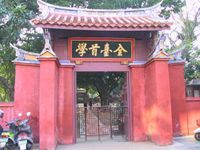
Over 93% of Taiwanese are adherents of a combination of Buddhism, Confucianism, and Taoism; 4.5% are adherents of Christianity, which includes Protestants, Catholics, Mormons, and other non-denominational Christian groups; and 2.5% are adherents of other religions, such as Islam. Taiwanese aborigines comprise a notable subgroup among professing Christians: "...over 64 percent identify as Christian... Church buildings are the most obvious markers of Aboriginal villages, distinguishing them from Taiwanese or Hakka villages."
Confucianism is a philosophy that deals with secular moral ethics, and serves as the foundation of both Chinese and Taiwanese culture. The majority of Taiwanese and Chinese usually combine the secular moral teachings of Confucianism with whatever religions they are affiliated with.
One especially important goddess for Taiwanese people is Matsu, who symbolizes the seafaring spirit of Taiwan's ancestors from Fujian and Guangdong.
Culture
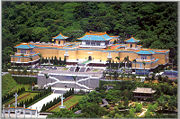
The cultures of Taiwan are a hybrid blend of Confucianist Han Chinese cultures, Japanese, European, American, global, local and indigenous influences which are both interlocked and divided between perceptions of tradition and modernity (Harrell/Huang 1994:1-5).
After the retreat to Taiwan, the Nationalists promoted an official interpretation of traditional Chinese culture over the local Taiwanese cultures. The government launched a program promoting Chinese calligraphy, traditional Chinese painting, folk art, and Chinese opera.
Since the Taiwan localization movement of the 1990s, Taiwan's cultural identity has been allowed greater expression. Identity politics, along with the over one hundred years of political separation from mainland China has led to distinct traditions in many areas, including cuisine, opera, and music.
The status of Taiwanese culture is debated. It is disputed whether Taiwanese culture is part of Chinese culture or a distinct culture. Speaking Taiwanese as a symbol of the localization movement has become an emblem of Taiwanese identity.
One of Taiwan's greatest attractions is the National Palace Museum, which houses more than 650,000 pieces of Chinese bronze, jade, calligraphy, painting and porcelain. The KMT moved this collection from the Forbidden City in Beijing in 1949 when it fled to Taiwan. The collection, estimated to be one-tenth of China's cultural treasures, is so extensive that only 1% is on display at any time.
Popular sports in Taiwan include basketball and baseball. Cheerleading performances and billiards are quite fashionable. Badminton is also common.
Karaoke, drawn from contemporary Japanese culture, is extremely popular in Taiwan, where it is known as KTV.
Taiwan has a high density of 24-hour convenience stores, which in addition to the usual services, provide services on behalf of financial institutions or government agencies such as collection of parking fees, utility bills, traffic violation fines, and credit card payments.
Taiwanese culture has also influenced other cultures. Bubble tea and milk tea are available in Australia, Europe and North America. Ang Lee has directed critically acclaimed films such as Crouching Tiger Hidden Dragon, Eat Drink Man Woman, Sense and Sensibility and Brokeback Mountain.
Leading technologies
- Semiconductor device fabrication
- Biotechnology
- Bicycle manufacturing

